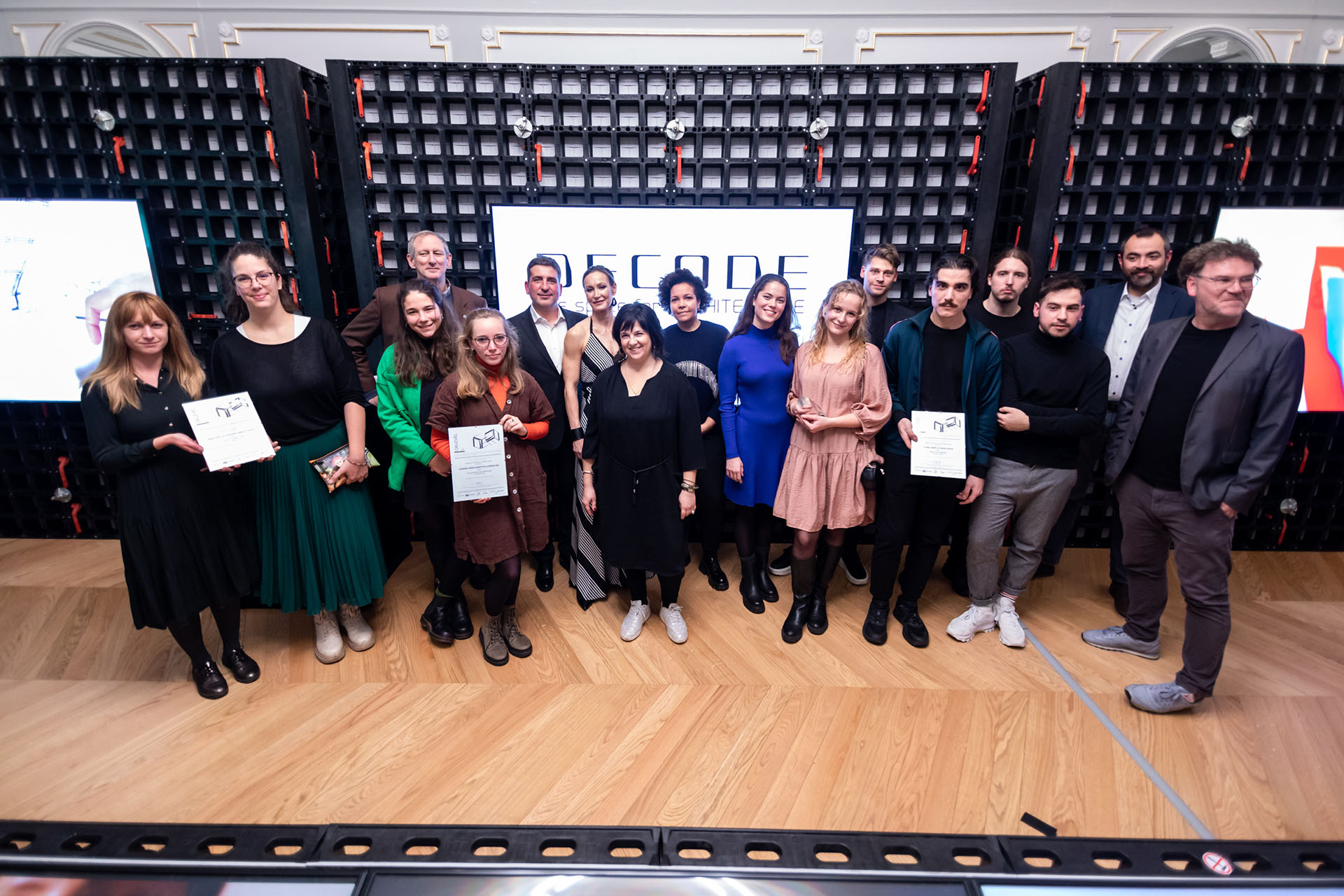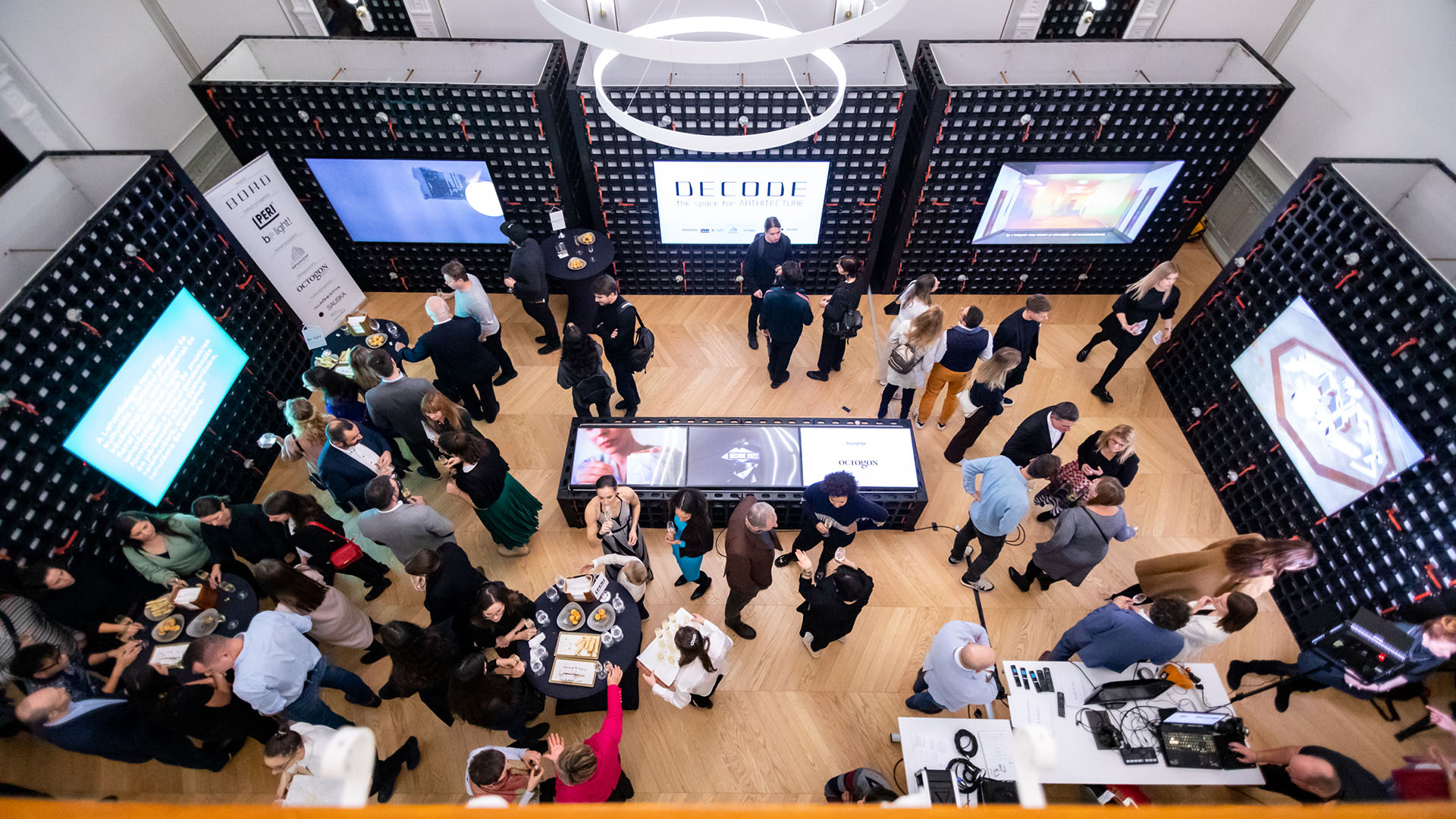„The good thing about DECODE is that there’s no ultimate recipe for a good design…” - DECODE 2022 Prizes have been awarded.
DECODE Prizes were handed out in the new location of Irányi Palace on November 16. The total sum of the remuneration was 2.1 Million HUF . The winner projects and exhibitors were selected by a professional jury from 64 entries. Apart from the two main categories there was also a Promising Project and a Spotlight Prize as well. The latter was given to the entry which was best in social engagement. Apart from the main Prize the winners also received a Trophy Prize designed by Fruzsina Zalavári.
The entries were judged by the Professional Jury of: Péter Bordás, Architect, Founder of BORD Architectural Studio and DECODE Foundation for Contemporary Architecture and Art Award, Head of Jury, Prof. Dr. Levente Szabó DLA, Ybl, Pro Architectura and Prima Prize awarded Architect, Professor and Head of Department of the Faculty of Architecture at Budapest University of Technology and Economics, Prof. Dr. Anthony Gall Phd, Ybl- and Pro Architectura Prize awarded Architect, Professor and Dean at the Ybl Miklós Faculty of Architecture and Civil Engineering, the University of Óbuda, János Golda Ybl, Prima and Pro Architectura Prize awarded Architect, Full Member of the Hungarian Academy of Arts, Borbála Kálmán, Art Historian, Curator of Ludwig Museum – Contemporary Museum of Arts , Etentuk Inemesit Cultural Manager, Founder of Artlocator Magazine, Dr. Krisztián Kukla, Art Director of Art Quartet Budapest (aqb)

The Winner of DECODE 2022 Award in the Category of Architecture
pre / MANÍR
by Lili Szaszák and Luca Bors
Creators’ Statement:
< mannerism: a characteristic, individual manner; the peculiar features of an artist’s work; eccentricity, strangeness >
Our first visit to the city of Eger left us with mixed emotions. On the one hand, we all have a familiar image about Eger in our minds that is also well known from books, films and public discourses: a place with great history and values. On the other hand, being in our twenties, walking the streets we are surprised to encounter how a snobbish, often superficial air has started to emerge here. Our generation and those citizens who refuse the delusions of grandeur are having difficulty finding programs and places where they could have fun or a cultural life, where one could be inspired freely and creatively. We have started planning cautiously, yet we have quite firm ideas. We used concrete as a base building material and created rough surfaces that invite people to touch and feel. The street façade offers only a blurry peep into the interior through a glass brick wall thus making the passer byes more interested in entering until they become so eager to check what’s inside that they cannot help but enter through a narrow street. Once inside, an alternative universe opens up in front of the eyes of the onlookers. This “hiding place” beholds a surprisingly vibrant atmosphere. The building is structured vertically. On the ground floor there is a pub and a community space, representing a venue for activities to meet one’s material needs. Taking the stairs upward one goes through a kind of filtering system reaching the floor of the tranquil studios. The atmosphere here is in strong contrast with the lush life downstairs. This is where one can nourish their spiritual and intellectual needs and can be creative without any unnecessary constraint or social pressure. We have formed a shell with the enclosed street façade that embraces the open spaces. The world inside is like a canvas, a scene for genuine creativity. Here, the walls can be covered with paint… because it’s the users/visitors who make the place real special.
Praise from Prof. Dr. Levente Szabó DLA, Ybl, Pro Architectura and Prima Prize awarded Architect, Professor and Head of Department of the Faculty of Architecture at Budapest University of Technology and Economics:
“Luca and Lili created an unusually positioned and shaped community building on a corner plot in Eger in their university design. Such a place is greatly missed in the city based on their experiences, apparently. Their aim was to create two floors with different characteristics and functions: on the ground floor there would be a pub for having casual social life while on the first floor there would be a studio – a space for creation and art. The ground floor is only loosely connected to the street, it stays almost hidden. There is a narrow staircase leading us to the first floor. These transitions function like filters between the public street and half public ground floor and between the ground floor and the first floor. This is a truly sensitive architectural idea, yet they did not receive first prize because of this. Their video interprets their architectural work in a very genuine way: it can explain the dramatic impact coded in their design and make us experience the atmosphere of the imagined spaces at the same time. While their entry project depicts the inside of the building with barely any lines in its spatial environment, the atmosphere of the place is represented by life in it such as scenes, noises and voices. The videos are excellent in showing us around upstairs and downstairs, the two spaces are shown after each other in short, reversed films. First we experience the colorfulness of the places, the creative and laid back presence, the characteristic of wide opportunities and then slowly everything is getting gradually empty, leaving just a couple of lines behind to represent architecture itself. As the true meaning of architecture is always what and how it provides function for.”
The Winner of DECODE 2022 Award in the Category of Visual and Applied Arts
Postal Museum x Poste Musée Loudéac
by Nóra Juhász
Creator’s Statement:
I established a Postal Museum in Loudéac, a small town in Bretagne, not far from Nantes. The institution opened about 15 years ago and can be found in 17 Rue de Pontivy. It belongs to the proud postal workers of Bretagne, the main aim of whom is to maintain and pass on the postal culture of the region. Being a small museum, it does not intend to compete with the French National Post Museum (La Post) and yet it has become so popular with the people of Loudéac and the regional stamp collectors that it has started expanding. Its managing director, Denise Barthelemy, one of the founders of the museum has been cooperating with a small team among whom there are postal workers and upcoming curators alike. One can Google it and find plenty of search results to prove its existence. Poste Musée Loudéac’s new goal is to set up an international cooperation. Marie Lejeune, communications director of Poste Musée Loudéac has written an email to the Budapest Postal Museum. Poste Musée is not a completed project; the correspondence still exists, just like the institution.
Praise from Dr. Krisztián Kukla, Art Director of Art Quarter Budapest (aqb):
“At first, I considered writing a fictitious letter when praising the entry project of Nóra Juhász. Then I figured maybe it should be more about elaborating on the ‘who shall deliver the post to the postman’ paradox but eventually I found myself checking out postal museums on the internet, inspecting them carefully like I used to do with the postmarks at the compulsory (or not?) stamp collecting faculty in school. The complex creation of Nóra Juhász seems to be based on a simple idea: we can follow a well-organized hoax step by step which is compassionate and offers a wide range of perspectives. Creating a virtual/fake postal museum and writing a letter in its name would only be half a success – only here there is a reply, in other words the performative gesture is completed and thus the non-existing institution becomes a real one. The artifact is an easy-going and detailed depiction of the realistic and virtual sceneries of art, and its video is equally playful and informative. At the end of the day Juhász makes a point about communication, that it can be best comprehended from the perspective of confusion and disorder. All in all her work is a brutally serious and a perfectly entertaining criticism of institutions, and last but not least a virtuosic tribute to mail art.”
Winner of DECODE 2022 "Promising Project" Award in the Category of Architecture
MICROHOME
by Kevin Kapui
Winner of DECODE 2022 "Promising Project" Award in the Category of Architecture
Dunaújvárosi strandkönyvtár
by Anna Dorottya Csanády and Liza Varga
Winner of DECODE 2022 "Promising Project" Award in the Category of Visual and Applied Arts
WELCOME HOME
by Kristóf Lázár
Winner of DECODE 2022 "Promising Project" Award in the Category of Visual and Applied Arts
FEED THE DRONES
by Máté Kovács – Ádám Takács
Winner of DECODE 2022 "Spotlight" Award
Lehetőségek tere – Práter 63
by Judit Árva and Zsófia Horváth-Farkas
DECODE 2022 Shortlisted Projects in the Category of Architecture
Pakli – Kata Baranyai, Boglárka Varga és Zsuzsanna Veres
Egy egyetemi projekt (meg nem) születése – Péter Csata , László Róbert Papp , Barnabás Szabó
DECODE 2022 Shortlisted Projects in the Category of Visual and Applied Arts
Afterlife – Luca Pataki
Live, Love, Laugh – Marcell Puskás
